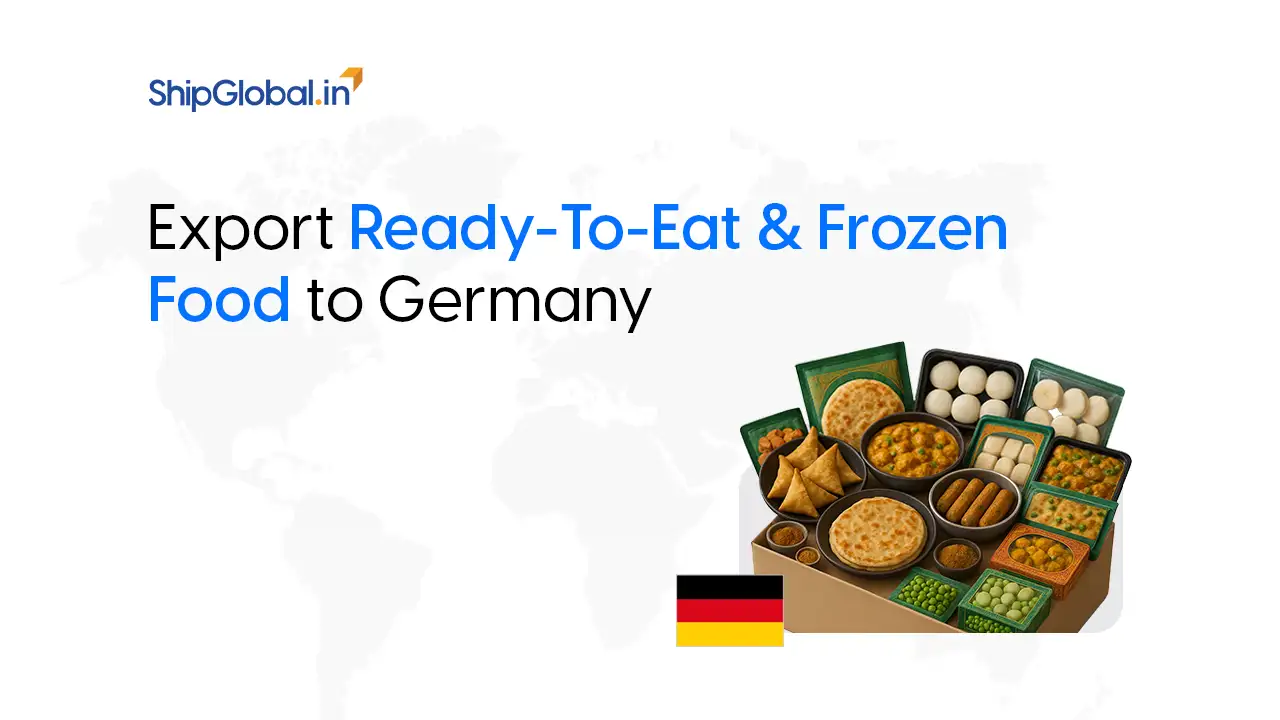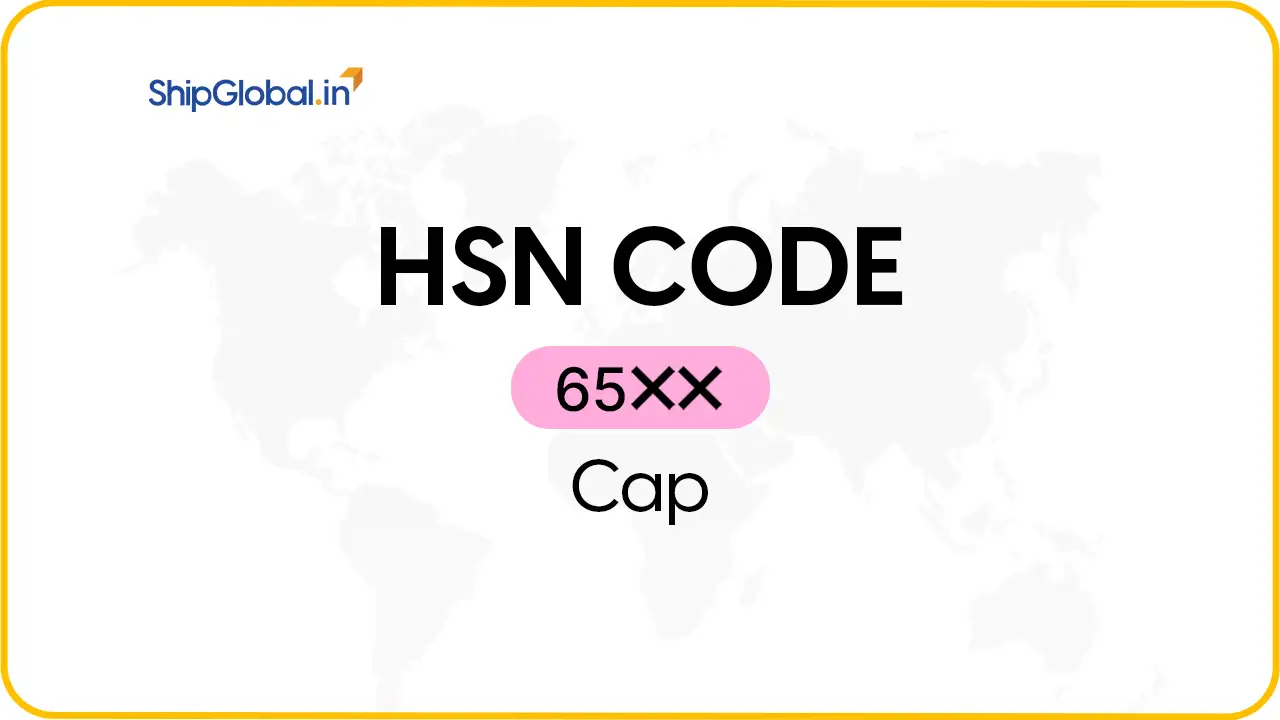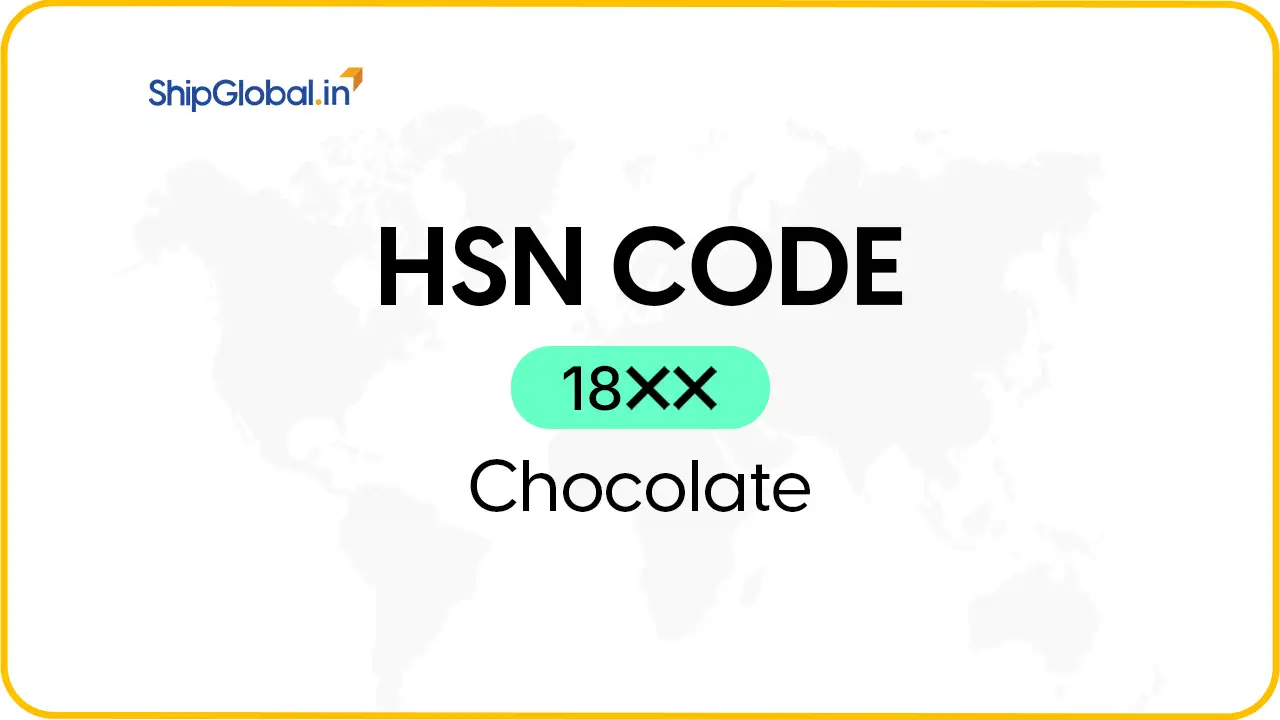Let’s be real—nobody likes late deliveries, skyrocketing fuel costs, or unhappy customers. If your logistics game isn’t tight, you’re probably bleeding time and money. But here’s the good news: with the right strategy, you can master your shipping routes and get packages where they need to go faster and cheaper.
Welcome to your go-to guide on route optimization. We’re diving deep into the ins and outs of delivery route planning, how to leverage real-time traffic data, navigate poor road conditions, align with your delivery schedules, and make intelligent distance calculations that drive reduced fuel costs and ensure faster delivery times.
Why Shipping Route Optimization Matters More Than Ever
In today’s fast-paced, customer-driven world, delivery isn’t just a logistics concern—it’s a brand promise. Your cross border shipping routes can make or break that promise. Whether you’re running a small local delivery business or managing a national fleet, route optimization ensures that every mile driven is a smart one.
Failure to optimize means more than just higher costs. It means potential missed delivery windows, lower customer satisfaction, and greater strain on your vehicles and staff. Businesses that master shipping route efficiency can scale faster, adapt quicker to disruptions, and deliver consistent, reliable service.
Benefits of Smarter Delivery Route Planning
Let’s break down exactly what you stand to gain with effective delivery route planning:
- Faster Delivery Times: Optimized routing means minimal detours and faster drop-offs.
- Reduced Fuel Costs: Shorter distances and smarter driving paths significantly lower your fuel spend.
- More Deliveries Per Day: When drivers spend less time stuck or circling around, they can hit more stops.
- Lower Maintenance Costs: Fewer miles and less idling mean less wear and tear on your fleet.
- Higher Customer Satisfaction: Reliable, on-time delivery improves customer trust and retention.
- Operational Efficiency: Streamlined routes free up management time and reduce scheduling headaches.
- Eco-Friendly Deliveries: Less fuel use and fewer emissions support your sustainability goals.
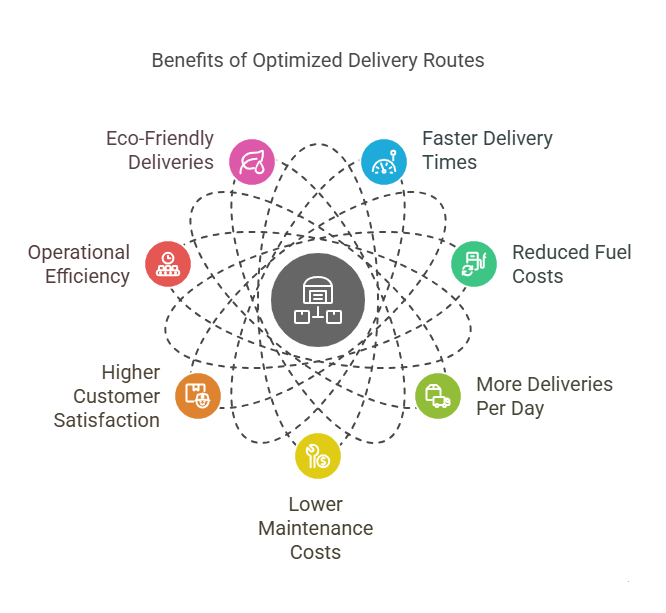
Core Components of Shipping Route Optimization
Let’s unpack what goes into creating the most efficient shipping routes:
Real Time Traffic Data
This is your secret weapon for optimized shipping. With access to real-time traffic data, your system (or dispatchers) can reroute deliveries around congestion, construction, and accidents instantly. GPS integration and predictive traffic tools help optimize delivery schedules, reduce delays, and ensure faster, more reliable shipments.
Road Conditions
Road conditions aren’t just about potholes. Think about seasonal hazards like snow, flooding, or extreme heat. Even construction zones and detours can add minutes or hours to your route. Smart delivery route planning incorporates historical and live road data to avoid problem areas.
Distance Calculation
Don’t fall for the trap of only considering mileage. The best distance calculation strategies account for:
- Traffic flow and signal stops
- Elevation changes
- Urban vs. rural delivery zones
- Stop frequency and timing windows
Smarter distance calculation means fewer surprises—and more reliable schedules.
Delivery Schedules
Customers love precision. And they expect it. Aligning your shipping routes with optimized delivery schedules (like prioritizing time sensitive packages) improves both experience and efficiency. Use route planning tools that allow dynamic scheduling and route reordering based on live conditions.
Driver Performance and Behavior
Drivers are the human element in your logistical machine. Tracking behavior—speeding, harsh braking, idling—allows managers to pair drivers with the right routes. It also highlights training opportunities and performance trends that affect shipping route efficiency.
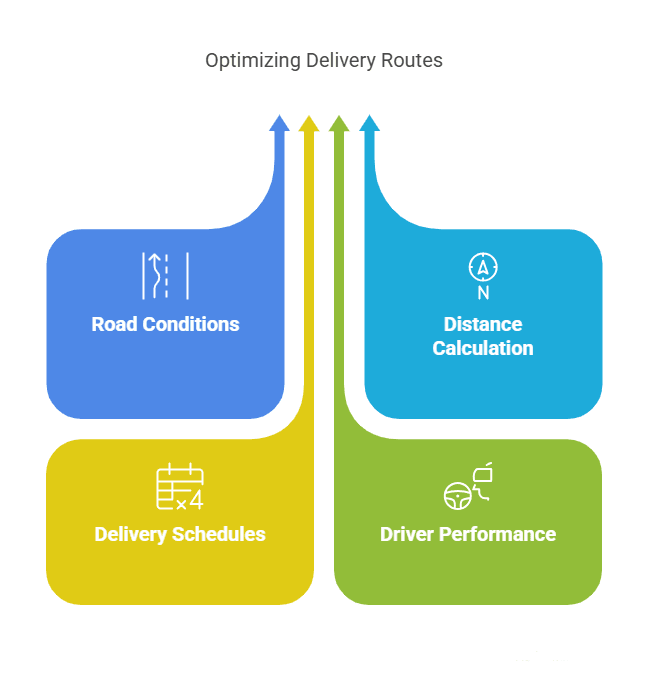
Tools That Supercharge Route Optimization
Whether you manage a few vans or a national fleet, these tools bring automation and precision to your delivery route planning:
Mapping and GPS Apps
Apps like Google Maps and Waze are great for individual drivers. They offer real-time navigation based on live road conditions and are perfect for low-volume delivery setups.
Route Optimization Software
For scaling businesses, platforms like Route4Me, Onfleet, Circuit, and OptimoRoute are game changers. These tools automate everything from distance calculation to multi-vehicle scheduling, route splitting, and even adjusting based on real time traffic data.
Fleet Management and Telematics
Hardware-based solutions monitor every movement of your fleet. Live vehicle tracking, fuel usage stats, maintenance alerts, and driver performance metrics all feed into smarter route optimization.
Integrated CRM and Logistics Platforms
By connecting your CRM with your route planning system, you can:
- Prioritize VIP or high-value customers
- Merge sales and delivery data
- Tailor shipping routes to individual customer needs
Pro Tips for Better Delivery Route Planning
Ready to take things up a notch? Try these next-level strategies:
1. Analyze Historical Delivery Data
Use past delivery data to understand patterns—delays, fuel usage, traffic bottlenecks. Then refine your delivery route planning with this insight.
2. Optimize Routes by Time of Day
Morning rush? Afternoon school zones? Optimize shipping routes not just by location, but time-specific data using predictive AI tools.
3. Cluster and Sequence Stops
Clustering nearby stops and planning logical delivery sequences can cut mileage by 20–30%. The result? Reduced fuel costs and more stops per shift.
4. Route Simulations and “What-If” Scenarios
Run simulations to test route changes before going live. This lets you explore alternate shipping routes, evaluate risks, and better manage unexpected changes.
5. Involve Drivers in Route Review
Your drivers know the streets better than software ever will. Regular feedback sessions help fine-tune shipping route efficiency and improve morale.
6. Create Backup Delivery Schedules
Weather happens. Accidents happen. Backup delivery schedules and alternate routing ensure you’re never caught off guard.
Beyond Efficiency: Route Optimization’s Strategic Value
Route optimization is more than a cost saving tactic. It drives strategic growth:
- Improved Forecasting: Better delivery route planning supports accurate resource planning and inventory control.
- Stronger Branding: Timely delivery builds reputation. Customers notice when you’re always on time.
- Agility and Scale: Efficient routing allows you to grow without overextending your workforce or vehicle assets.
- Sustainability Goals: Less fuel and fewer miles help you hit environmental benchmarks and market your business as green.
Case Study: Scaling with Smarter Routes
A nationwide courier service with over 200 delivery vehicles switched to an AI-driven route optimization platform. Here’s what they achieved in just six months:
- 28% reduction in fuel costs
- 40% fewer late deliveries
- 20% increase in total deliveries per day
- Driver satisfaction improved due to fewer route changes and realistic schedules
The key? Leveraging real time traffic data, continuously updating road condition info, and applying advanced distance calculation tools.
Roadblocks to Watch For
Even with great tools and planning, delivery route planning faces challenges:
- Sudden traffic jams or closures
- Incomplete or outdated map data
- Local regulations (e.g., weight restrictions, curfews)
- Poor coordination between sales and delivery teams
- Limited visibility without real time tracking
Solution? Layer your tech—combine GPS, telematics, AI, and human feedback for unbeatable shipping route efficiency.
What’s Coming Next in Route Optimization
The future of route optimization is more connected and autonomous:
- Machine Learning: Learns from every delivery to improve next ones automatically
- Electric Vehicle Routing: Planning routes based on battery capacity, not just fuel
- IoT-Connected Fleets: Smart sensors that share traffic and road conditions in real-time
- Drone Delivery Integration: Airborne deliveries supplementing road based routes
- AR Navigation: On-screen overlays for better visibility in urban environments
Final Thoughts: Make Every Mile Count
Optimizing your shipping routes isn’t a one-time fix. It’s an ongoing investment in efficiency, customer satisfaction, and profitability. With the right tech stack, strong data strategy, and human insight, delivery route planning becomes your competitive advantage.
Every route, every driver, every delivery can be smarter. The result? Faster delivery times, reduced fuel costs, and a logistics operation that just works.
So go ahead—map smarter, drive less, deliver more. Your customers (and your bottom line) will thank you.
FAQs
Route optimization is the process of determining the most efficient way for delivery drivers to reach their stops, minimizing distance, time, and fuel usage while considering traffic, road conditions, and delivery priorities.
Real-time traffic data helps reroute deliveries around congestion, accidents, or road work, ensuring drivers stick to their schedules and avoid delays.
Software solutions automate delivery route planning, factoring in multiple stops, vehicle capacities, driver schedules, traffic patterns, and fuel efficiency to create the most optimized shipping routes.
Absolutely. By minimizing unnecessary travel, reducing idle time, and avoiding traffic-heavy routes, route optimization can significantly lower fuel consumption.



